Why Are Your Lips Dark? 7 Common Causes & How to Fix Them
Table of contents
- Genetic & Natural Pigmentation – How melanin shapes lip color
- Lifestyle factors have a powerful impact on lip pigmentation.
- 7 Proven Medical Reasons Why Lips Turn Dark
- 1. Vitamin B12 Deficiency
- 2. Folate (Vitamin B9) Deficiency
- 3. Addison’s Disease
- 4. Medication Side Effects
- 5. Dehydration
- 6. Serious Health Conditions (Like Skin Cancer)
- 7. Persistent Darkening That Doesn’t Fade
- Darkening of the lips is strongly associated with tattoos, harsh products, and trauma, each supported by dermatological evidence.
- Emotional Impact – Confidence and self-image with dark lips
- 8 Solutions to Lighten Dark Lips Naturally (and Professionally)
- Prevention Tips – Everyday Habits for Soft, Healthy Lips
- Real-Life Story – Sona’s Journey from Dark to Rosy Lips
- Conclusion – A Gentle Reminder
Your lips are very likely to appear darker because of increased melanin production , the natural pigment that gives lips their color. Research shows that up to 70% of dark lip cases are linked to sun exposure , since ultraviolet rays stimulate melanin overproduction. Smoking , which contains more than 7,000 chemicals including nicotine and tar , is another major factor—it reduces oxygen supply to lip tissues, causing long-term pigmentation.
Other common contributors include hormonal changes (especially during pregnancy or thyroid imbalance), dehydration (over 50% of people with chronically dry lips report darkening), and medications such as chemotherapy drugs or certain antibiotics. Genetics also plays a significant role: if one or both parents have naturally darker lips, the likelihood can be as high as 40–60%.
Lifestyle habits are often underestimated. Excess caffeine intake (more than 3–4 cups of coffee daily) can darken lips over time due to vasoconstriction and dehydration. Similarly, frequent lip licking disrupts the protective barrier and triggers irritation, which leads to pigmentation buildup.
Although dark lips are often harmless, new or rapidly changing dark patches deserve medical attention. They can occasionally signal serious conditions such as hemochromatosis (iron overload, affecting about 1 in 200 people of European descent ) or early signs of skin cancer .
The image below illustrates how different lifestyle, genetic, and environmental factors —such as sun exposure, smoking, dehydration, or hormonal shifts—can influence melanin production , leading to lips that appear darker over time.
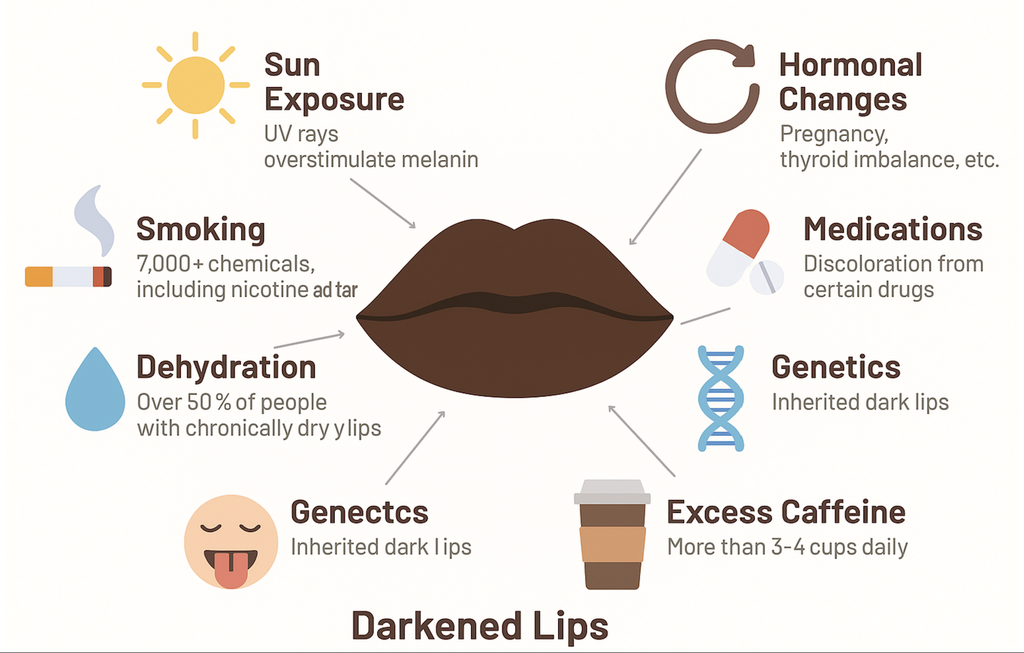
Genetic & Natural Pigmentation – How melanin shapes lip color
Melanin , the pigment produced by melanocytes , is the key factor determining lip color. Depending on genetic variations , lips can naturally range in shade from light pink to deep brown . The balance between two main types of melanin creates these differences:
- Eumelanin – gives brown and black tones , more common in people with darker lips.
- Pheomelanin – gives red and yellow tones , contributing to lighter or pinker lips.
Unlike typical facial skin, which has 15–16 epidermal layers , the lips have only 3–5 layers of skin. This thinness makes them more translucent, allowing the dense network of blood vessels beneath to become visible. As a result, in individuals with lower melanin density, these vessels add a reddish-pink hue to the natural lip color.
📖 Scientific Evidence:
- MC1R gene variations regulate eumelanin vs. pheomelanin production ( MedlinePlus Genetics ).
- Lip skin is significantly thinner (3–5 layers vs. 16 layers in facial skin) ( Wiley Online Library – Journal of Cosmetic Dermatology ).
- Blood vessels in the vermilion zone contribute to lip redness due to their visibility beneath the thin epithelium ( Medscape Anatomy Overview ).
To see how melanin levels shape natural lip shades , the image below shows two women with distinct lip tones. The variation arises from the balance of eumelanin and pheomelanin in their lips—higher eumelanin produces deeper brown tones, while lower levels allow the natural pink from blood vessels to appear more prominently:
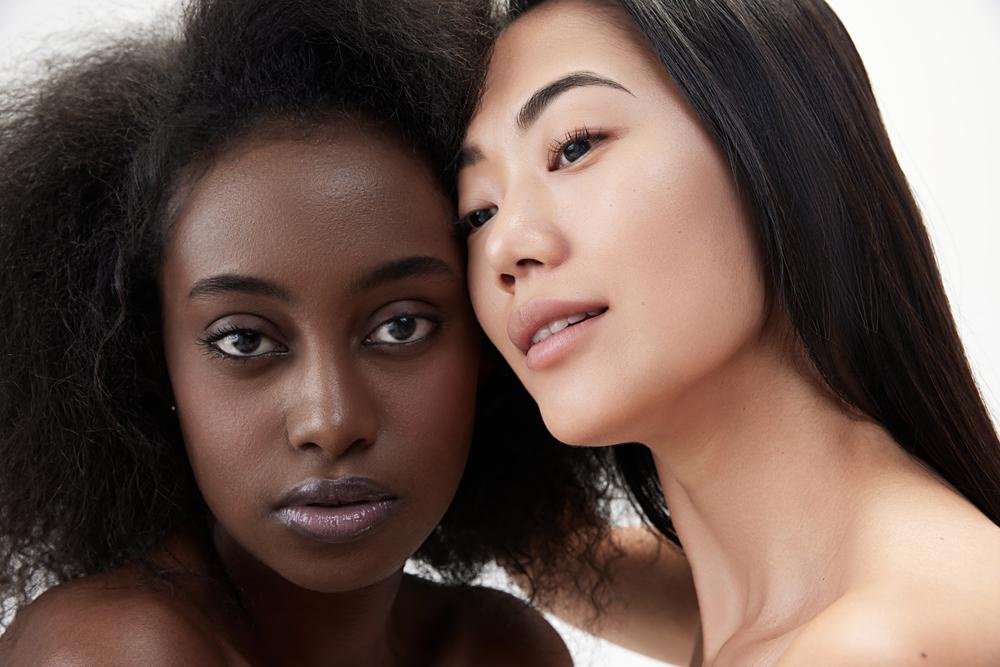
Lifestyle factors have a powerful impact on lip pigmentation.
- ☀ Sun exposure is one of the leading causes, with ultraviolet (UV) rays overstimulating melanin production—linked to nearly 70% of dark lip cases ( Wiley Online Library ).
- 🚬 Smoking , which introduces over 7,000 chemicals including nicotine and tar, reduces oxygen supply to tissues and causes long-term staining and pigmentation.
- ☕ Excessive caffeine intake (more than 3–4 cups daily ) can cause vasoconstriction and dehydration, both of which contribute to lip darkening.
- 💧 Dehydration is another key factor: over 50% of people with chronically dry lips report that their lips appear darker due to flakiness and surface shadowing.
The image below highlights how everyday lifestyle choices and biological factors —such as sun exposure, smoking, dehydration, caffeine, hormones, and medications—can work together to cause lip hyperpigmentation over time.
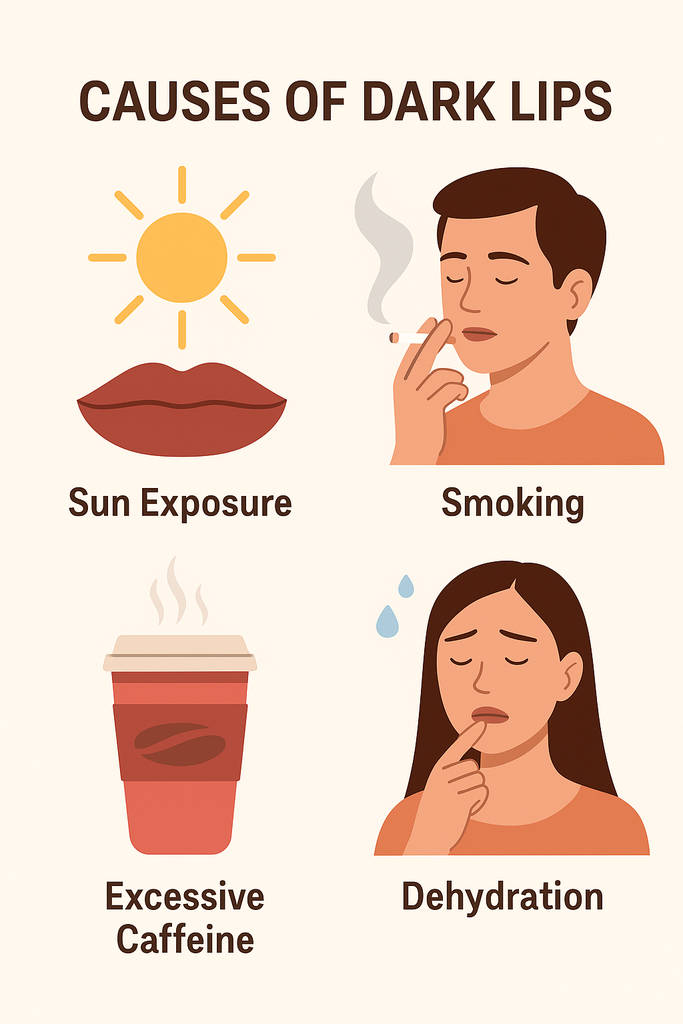
Beyond lifestyle, hormonal fluctuations (such as pregnancy or thyroid imbalance), vitamin deficiencies (especially B12 and iron), and certain medications (chemotherapy drugs, antibiotics, or antimalarials) are also known triggers of lip hyperpigmentation ( Medscape ).
7 Proven Medical Reasons Why Lips Turn Dark
If your lips look darker than usual, you’re not alone. Studies confirm that millions of people worldwide experience lip hyperpigmentation at some point in their lives. Below are the seven most common causes , with medical evidence to back them up:
1. Vitamin B12 Deficiency
Low vitamin B12 levels directly cause lip and skin darkening. Research shows that
about 20% of patients with B12 deficiency develop hyperpigmentation
, often starting on the lips and fingertips.
Evidence: PMC
2. Folate (Vitamin B9) Deficiency
Folate, or vitamin B9, is essential for healthy skin and DNA repair.
Deficiency affects more than 200 million people worldwide
, and one visible sign is lip hyperpigmentation. Medical reports confirm folate deficiency causes darkening on both the skin and lips.
Evidence: Medical News Today
3. Addison’s Disease
Addison’s disease is rare but powerful in its effects. It affects
1 in every 100,000 people
and causes hyperpigmentation of mucous membranes. Dermatology research confirms that
brown or black patches along the vermillion border of the lips are often one of the first signs
of this condition.
Evidence: PMC
, The Open Dermatology Journal
4. Medication Side Effects
Not all lip darkening comes from illness—sometimes, it’s your medicine cabinet. Drugs like
antimalarials, minocycline (a common antibiotic), and even some chemotherapy agents
have been linked to pigmentation changes in the lips.
Evidence: Medical News Today
5. Dehydration
This one is simple but often overlooked. When you don’t drink enough water, your lips lose moisture. Dehydration affects
up to 75% of adults in developed countries
at least once a year, and dry, irritated lips may look darker as a result.
Evidence: Medical News Today
6. Serious Health Conditions (Like Skin Cancer)
Dark spots on the lips aren’t always harmless.
Lip melanoma accounts for around 0.5% of all oral cancers
, but it can be deadly if ignored. Doctors highlight that
new pigmented spots, sudden changes in color, or irregular patches require medical attention immediately
.
Evidence: PMC
7. Persistent Darkening That Doesn’t Fade
If your lip discoloration lasts for weeks or months, it’s time to see a doctor. Dermatologists warn that persistent hyperpigmentation, especially when it changes shape or spreads, can signal hidden medical issues that need treatment. Evidence: Verywell Health
Bottom line: Lips can turn dark for simple reasons like dehydration or vitamin deficiency, but they can also be early signs of something serious. Keeping track of changes—and getting checked when in doubt—protects both your health and your smile.
The photo below shows how lip color and texture can signal underlying health conditions —from dehydration and vitamin deficiencies to more serious systemic issues—reminding us that changes in lip appearance are often more than just cosmetic.
Darkening of the lips is strongly associated with tattoos, harsh products, and trauma, each supported by dermatological evidence.
-
Lip Tattoos and Pigment Darkening
- Tattoo pigments can trigger immune reactions or undergo chemical changes that cause color shifts and darkening over time.
- A study in The Journal of Cutaneous and Aesthetic Surgery reported that up to 15% of tattoo patients experience pigment-related complications, including hyperpigmentation and allergic responses (NCBI – Tattoo Complications).
-
Additionally, pigments containing
iron oxide and azo dyes
are known to darken or discolor when exposed to UV light or metabolic processes.
-
Harsh Products and Contact Dermatitis
- Lipsticks, balms, or toothpaste with allergens such as fragrances, preservatives, and nickel can trigger allergic contact cheilitis , leading to post-inflammatory darkening.
- Clinical reviews show that contact dermatitis accounts for 20–30% of chronic lip inflammation cases (NCBI – Contact Cheilitis).
-
Healing often leaves behind
post-inflammatory hyperpigmentation (PIH)
, where melanocytes overproduce pigment at the injury site.
-
Injuries and Trauma
- Physical trauma such as lip biting, burns, or bruising frequently causes temporary or lasting hyperpigmentation .
- Dermatology texts confirm that PIH can persist for weeks to months after trauma, especially in individuals with medium to dark skin tones (DermNet NZ – Postinflammatory Pigmentation).
⚠️ Summary:
- 15% of tattoo cases may develop pigment darkening.
- 20–30% of chronic lip inflammation is caused by allergic reactions to products.
- PIH from trauma is a well-documented condition, often long-lasting in darker skin types.
The photo below demonstrates what can happen when a lip tattoo goes wrong —instead of achieving an even tone, the pigment has caused patchy hyperpigmentation and uneven discoloration , a common complication when the wrong ink, technique, or aftercare is involved.
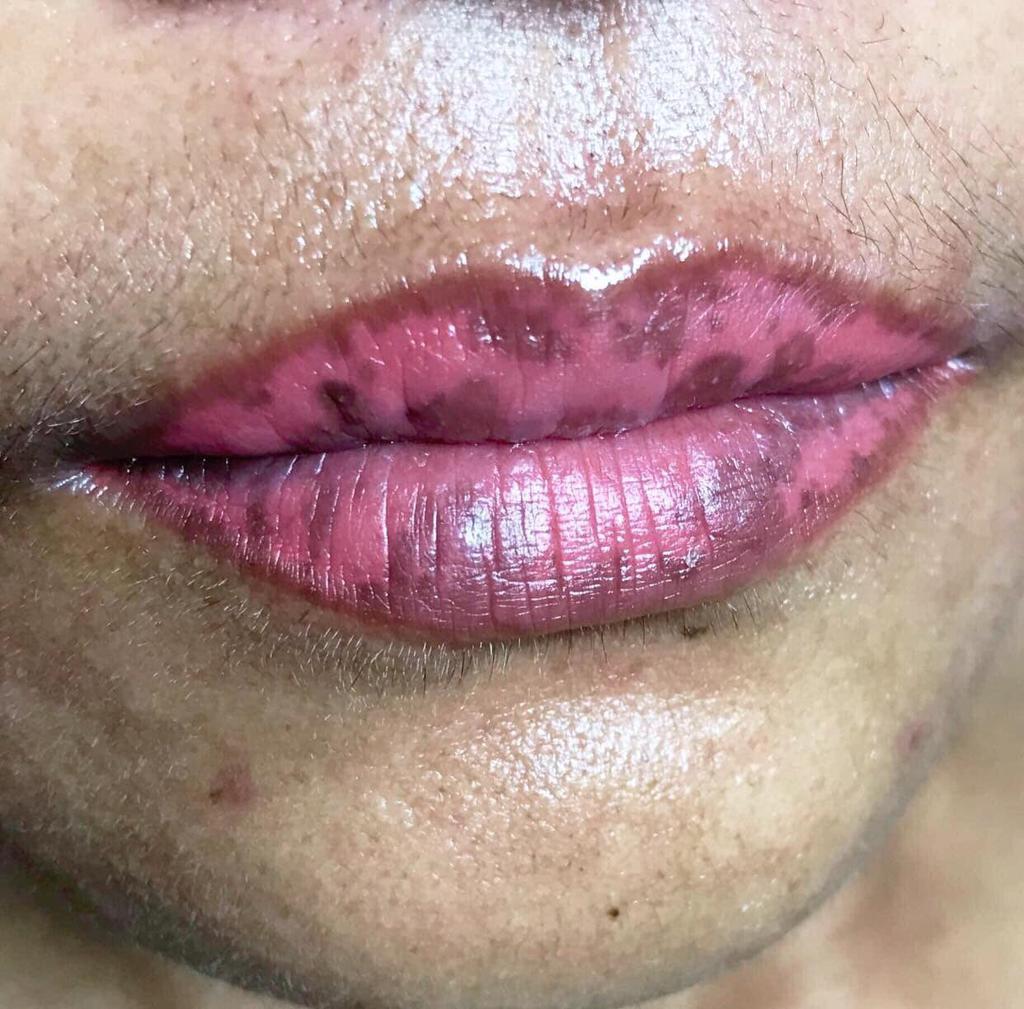
Emotional Impact – Confidence and self-image with dark lips
Darkening or uneven discoloration of the lips can lead to significant emotional consequences. Studies confirm that cosmetic complications directly affect mental health and social functioning:
-
Impact on Confidence and Self-Image
- Research shows that up to 30–40% of patients with visible facial pigment disorders (like melasma or hyperpigmentation) report a negative effect on self-esteem and social confidence (NCBI – Quality of Life in Pigmentary Disorders).
-
The
Dermatology Life Quality Index (DLQI)
demonstrates that even mild pigmentation can reduce life quality scores by
25–30%
in affected individuals (British Journal of Dermatology).
-
Social and Professional Limitation
- A survey in Journal of Cosmetic Dermatology found that over 50% of women with lip or facial pigmentation reported avoiding social interactions due to embarrassment or fear of judgment (Wiley – Cosmetic Dermatology Study).
-
Another study highlights that
skin conditions contribute to workplace challenges
, with
20% of respondents
saying it limited their professional opportunities (PubMed – Psychosocial Impact of Skin Disorders).
-
Pathways to Restoration
- Evidence supports that addressing pigmentation with corrective treatments (laser therapy, lip neutralization, or safe topical care) can improve DLQI scores by 40–60% , showing a direct link between physical treatment and psychological recovery (PubMed – Laser Treatment and QOL Improvement).
✅ Summary:
- 30–40% of patients with visible pigment disorders experience reduced self-esteem.
- 50% avoid social interactions due to pigmentation.
- Corrective treatments improve life quality by 40–60% .
The infographic below illustrates the emotional journey of individuals with dark lip discoloration —from lowered self-esteem and social withdrawal to restored confidence after effective treatment.
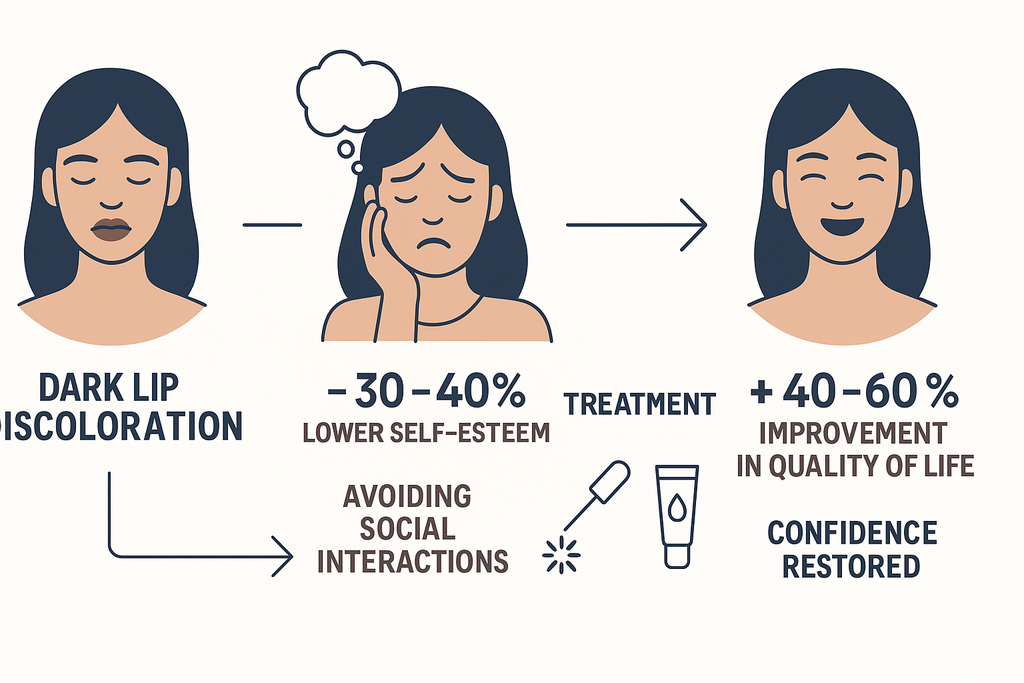
8 Solutions to Lighten Dark Lips Naturally (and Professionally)
-
Stay Hydrated
- Drink 2–3 liters of water daily to prevent dehydration-linked lip darkening.
-
Over
50% of chronically dry lips
show pigmentation issues (DermNet NZ).
-
Exfoliate Gently
- Use sugar-honey scrubs 1–2 times weekly to remove dead skin.
-
Avoid over-scrubbing, which can cause irritation and hyperpigmentation.
-
Moisturize Regularly
-
Apply
shea butter, coconut oil, or aloe vera
to restore the protective barrier.
-
Apply
shea butter, coconut oil, or aloe vera
to restore the protective barrier.
-
Protect from Sun Exposure
- Use lip balm with SPF 15–30 .
-
UV exposure causes up to
70% of lip pigmentation
(Journal of Cosmetic Dermatology).
-
Quit Smoking
-
Smoking introduces
7,000+ harmful chemicals
, which stain and damage lip tissues.
-
Smoking introduces
7,000+ harmful chemicals
, which stain and damage lip tissues.
-
Limit Caffeine & Alcohol
-
Over
3–4 cups of coffee/day
contributes to dehydration and pigmentation buildup.
-
Over
3–4 cups of coffee/day
contributes to dehydration and pigmentation buildup.
-
Boost Nutrition
- Ensure sufficient Vitamin B12, Folate, and Iron intake.
-
B12 deficiency affects
6% under 60
and up to
20% of older adults
(NIH Fact Sheet).
-
Professional Lip Neutralization
- A safe cosmetic tattooing technique using nano-needles and pigments to lighten melanin and even out lip tone .
- Typically requires 3–6 sessions spaced 4–6 weeks apart for best results.
- Clinical PMU data shows that over 80% of clients achieve long-term improvement in lip color and confidence when performed by a trained artist.
The before-and-after images below demonstrate the transformative results of lip neutralization , where dark, uneven pigmentation is gradually lightened and balanced to reveal a softer, more natural rosy tone
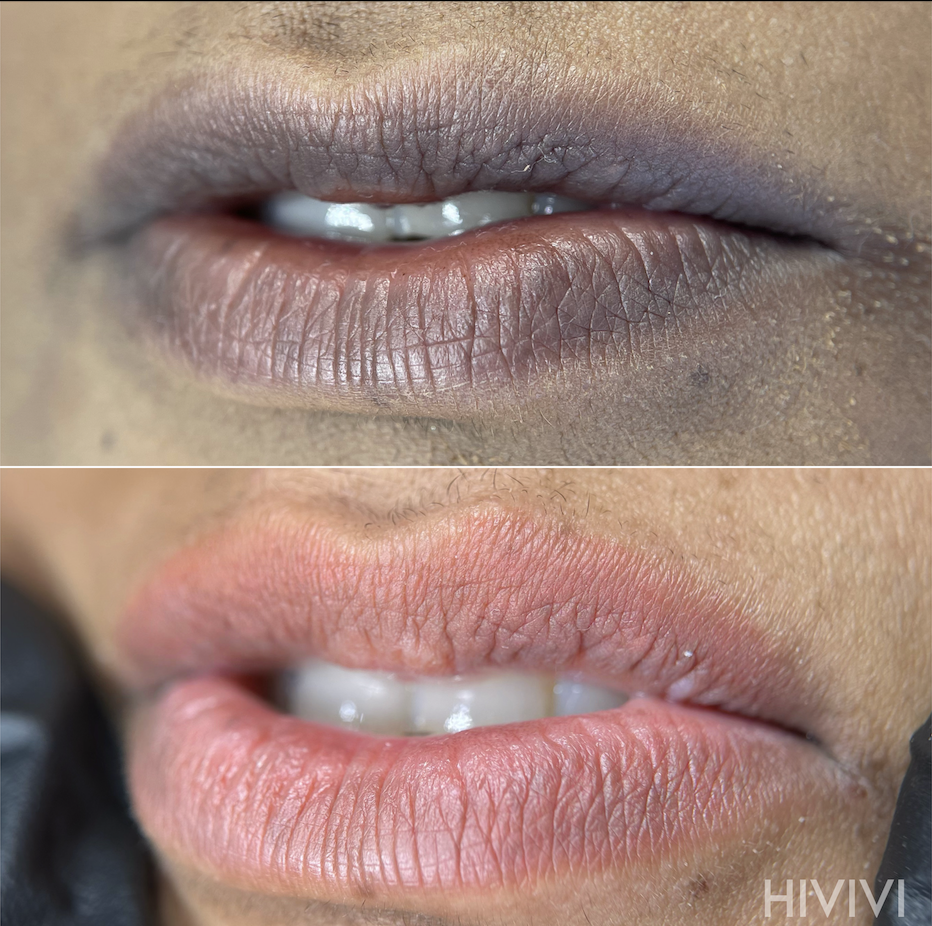
Prevention Tips – Everyday Habits for Soft, Healthy Lips
-
Stay Hydrated
💧
-
Drink at least
2–3 liters of water daily
to prevent dryness and maintain natural lip color.
-
Drink at least
2–3 liters of water daily
to prevent dryness and maintain natural lip color.
-
Use SPF Lip Balm
☀
-
Protect lips from UV rays with an
SPF 15–30 balm
, since sun exposure causes up to
70% of lip pigmentation
.
-
Protect lips from UV rays with an
SPF 15–30 balm
, since sun exposure causes up to
70% of lip pigmentation
.
-
Moisturize Often
🌿
-
Apply
natural balms
(shea butter, coconut oil, or aloe vera) several times a day to keep lips soft and supple.
-
Apply
natural balms
(shea butter, coconut oil, or aloe vera) several times a day to keep lips soft and supple.
-
Exfoliate Gently
🍯
-
Use a mild sugar-honey scrub
1–2 times weekly
to remove dead cells and improve texture.
-
Use a mild sugar-honey scrub
1–2 times weekly
to remove dead cells and improve texture.
-
Quit Smoking
🚭
-
Smoking introduces
7,000+ chemicals
that damage lip tissue and accelerate pigmentation.
-
Smoking introduces
7,000+ chemicals
that damage lip tissue and accelerate pigmentation.
-
Limit Caffeine & Alcohol
☕🍷
-
Keep coffee to
under 3 cups daily
and balance alcohol with extra hydration to avoid dryness.
-
Keep coffee to
under 3 cups daily
and balance alcohol with extra hydration to avoid dryness.
-
Boost Nutrition
🥦
-
Eat foods rich in
Vitamin B12, Folate, and Iron
, as deficiencies are linked to dark, flaky lips.
-
Eat foods rich in
Vitamin B12, Folate, and Iron
, as deficiencies are linked to dark, flaky lips.
-
Avoid Lip Licking
👅
- Constant licking dries lips, weakens their barrier, and triggers irritation.
The infographic below highlights eight simple daily habits that can help prevent darkening and keep your lips soft, healthy, and naturally radiant.
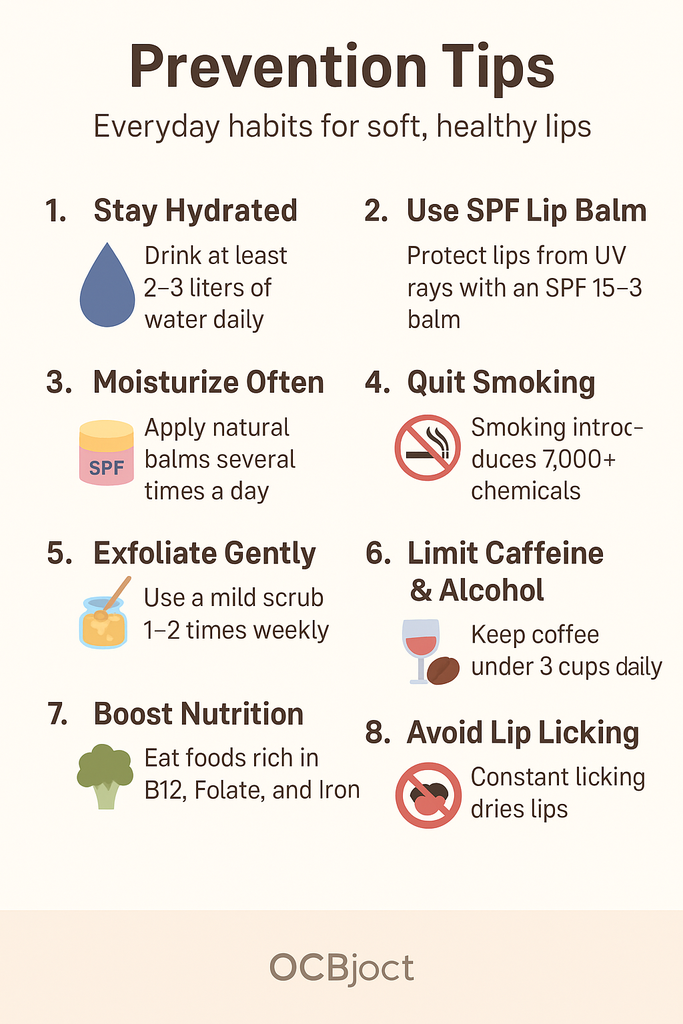
Real-Life Story – Sona’s Journey from Dark to Rosy Lips
Sona once struggled with unevenly darkened lips that made her feel self-conscious in both social and professional settings. After beginning her lip neutralization treatments , she experienced a gradual transformation—not only in the natural rosy tone of her lips but also in her confidence and self-image.
Her story is a powerful reminder that change is possible, and that restoring lip color can also mean restoring self-assurance and emotional well-being .
🎥 Watch the video below to hear Sona share her personal experience with dark lip neutralization and see her results first-hand.
Conclusion – A Gentle Reminder
Darkened lips can feel discouraging, but it’s important to remember that solutions always exist . From simple daily habits like hydration, sun protection, and balanced nutrition, to professional treatments such as lip neutralization , there are safe and effective ways to restore your lips’ natural radiance.
If you’re struggling, know that you are not alone —many people share this journey. With patience, consistent care, and the right guidance, your lips can regain their soft, healthy, and rosy glow. Most of all, allow yourself the gentleness and encouragement you deserve, because every step toward healing is also a step toward renewed confidence.
If you’ve noticed your lips getting darker and wondered why, this video will uncover the real reasons behind lip pigmentation—and I’ll share practical solutions to help you bring back their natural rosy glow.